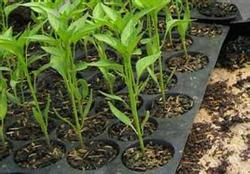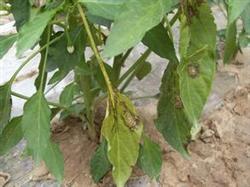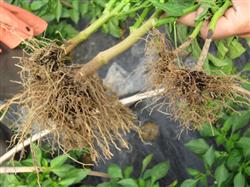It is not appropriate to transfer seedlings and control the growth of hot pepper.

At present, because some vegetable farmers have not yet cleared the shed, and the pepper seedlings are growing very fast, in order to prevent the seedlings from growing too fast, they have adopted the method of transplanting seedlings to control their growth, especially since many seedlings have grown to 6-8 leaves. In this regard, the reporter believes that this approach is very undesirable. First of all, transplanting seedlings injures roots, and the seedling stage is prolonged, which can easily lead to root aging, weaken regeneration ability, and affect the growth of seedlings after planting. The seedling stage is the most delicate and fragile period of the root system, although the seedling soil is soft and the root is less cut in the process of seedling transfer, the root system will still be greatly damaged. Transplanting seedlings prolonged the seedling age, which easily led to root aging, weakening of regeneration ability, slow growth and weak growth after planting. Secondly, when transplanting seedlings, wounds are easy to form on the roots and stems, which affect the disease resistance of seedlings. In recent years, root disease has become the most important disease restricting vegetable production. When vegetable seedlings are transferred, root injury is inevitable, and the wound becomes an excellent place for pathogen infection, which can easily lead to disease. At the same time, the fine hairs on the stem of pepper seedlings played a very important role in reducing pathogen transmission and infection. However, the fine hairs on the stem will inevitably be hurt when the seedlings are transferred, resulting in the decrease of plant disease resistance and the increase of disease occurrence. In addition, flower bud differentiation was greatly affected. The flower bud differentiation of most vegetables starts from the stage of 2-4 true leaves. If root injury or disease occurs during this period, it is bound to affect the absorption of water and nutrients by the root system and the photosynthesis of leaves, resulting in the plant not getting enough nutrition. Flower bud differentiation is delayed and poor, and there are many abnormal fruits and low yield in the early stage after planting. Seedling planting is more beneficial to the growth and development of vegetables. Vegetable farmers must calculate the time before planting or fixing seedlings, not too early, lest the seedlings are too large before planting, have to control the growth, and affect the growth and development of seedlings after planting. If the seedlings are indeed larger and cannot be planted for a while, the seedlings in the point plate can be transplanted into the nutrition bowl first, and the growth space and nutrition range can be controlled to help them grow and prolong the seedling age.
- Prev

Introduction to the symptoms and control methods of pepper blight
Control methods: 1. Pepper blight is mainly harmful to leaves, fruits and stems, especially at the base of stems. 2. The disease occurs in the seedling stage, mostly from the base of the stem, the disease part appears watery soft rot, the disease spot is dark green, and lodging above the disease part. Prevention and control methods: 1, the implementation of crop rotation, deep turning to improve the soil, knot.
- Next

Three points should be paid attention to to replenish seedlings after the death of hot pepper.
Recently, some vegetable farmers went to the Denong supermarket in Qingzhou to report that the dead chili trees that had just been planted were serious, and even the newly replenished pepper seedlings were not growing well and were easy to be infected with diseases, resulting in dead trees. The author observed in the arched shed of vegetable farmers and found that this situation was mainly caused by improper seedling replenishment methods. How about that.
Related
- Where is it suitable to grow horseradish in China? it is expected to see the middle altitude horseradish in Alishan.
- How to prevent tomato virus disease reasonably? (Control methods included)
- Many people like to plant towel gourd on the balcony. What are the main points of this method and management?
- What crops can chili peppers be mixed with?
- Fertilization techniques and matters needing attention in Tomato
- What are the grafting techniques for peach seedlings in spring?
- Harm and control methods of root swelling disease of Chinese cabbage
- What are the pests of sweet potatoes? How to prevent and cure it?
- Symptoms, causes and Control methods of navel Rot in Tomato
- The cause of "Cucumber rotten bibcock" in Farmers' planting Cucumber and its Control Plan

